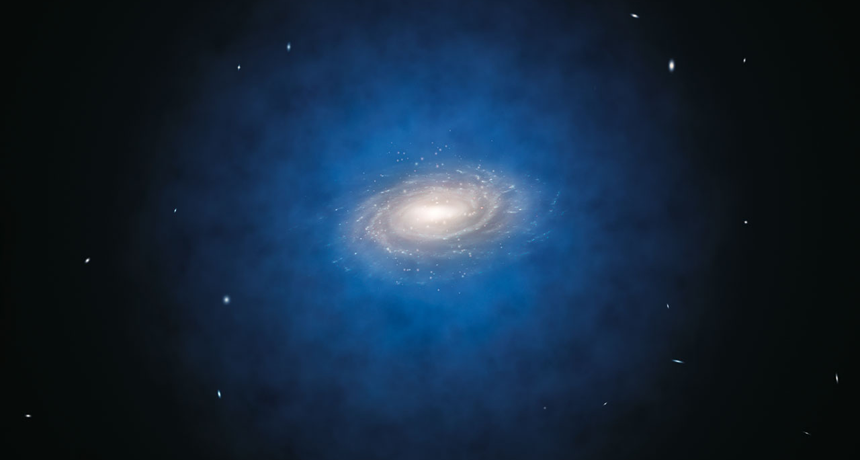Dark matter search turns up empty
Star study suggests our cosmic neighborhood may be lacking invisible matter

Scientists expected the Milky Way galaxy to be nestled inside a large sphere of dark matter, depicted here as a fuzzy blue cloud. But a new study suggests that there is no dark matter in the neighborhood of our sun.
L. CALÇADA/ESO
They say that what you see is what you get. But if you’re an astronomer studying a particular gaggle of stars, what you see might leave you scratching your head.
A team of astronomers in Chile recently tracked the motion of about 400 nearby stars zooming through space. If the scientists’ calculations are correct, then the stars are flying through space that lacks dark matter. Because those stars are so close to our solar system, the study suggests that there’s no dark matter around Earth and the sun. That’s a problem because dark matter is believed to be everywhere in our galaxy, the Milky Way.
Most astronomers agree that the majority of the matter in the universe is dark matter, which is invisible. Ordinary matter makes up the world we know, including the rain and video games and dirt and you. Any object that either shines or reflects light, like a star or planet, is made of ordinary matter.
Dark matter doesn’t produce or reflect any light, so it must be something else. This invisible stuff poses a big challenge for astronomers: Since we can’t see it, we can’t measure it directly. Dark matter is detectable only because its gravity — an attractive force between objects with matter — pulls on stuff we can see.
Dark matter has been useful in explaining other head-scratchers about space. The spiral-shaped Milky Way, for example, spins too fast to contain only ordinary matter like stars, planets and dust. But if you include dark matter and its gravity, which gives the galaxy an extra oomph, the speedy spin makes sense.
Scientists suspect that the Milky Way lies within a giant blob of dark matter. The dark matter blob is usually thought of as a giant sphere surrounding the galaxy and stretching beyond it. But this new study suggests that perhaps our galaxy’s dark matter has a different shape.
The Milky Way itself is shaped like a disk, or a Frisbee. Viewed from the top or bottom, it looks like a giant spiral. From the side, it looks flat. The astronomers in Chile studied the movements of stars flying through space above our solar system’s section of the Milky Way. The stars seemed to be moving through space as though dark matter’s gravity wasn’t pulling on them. That finding suggests the stars — and probably us, because we’re not so far away — are flying through a patch of space with no dark matter.
“This doesn’t mean that dark matter does not exist,” study leader Christian Moni Bidin, an astronomer at the Universidad de Concepcion in Chile, told Science News. “The result is only that dark matter is not where we expected it.”
If Moni Bidin and his colleagues are correct, then astronomers may need to rethink the shape of the dark matter blob that surrounds the Milky Way. Maybe it’s not a sphere.
For example, if the dark matter blob were shaped like an American football standing on its end, it could cut right through the center of the galaxy. (Imagine a football whose center is stuck in the middle of a Frisbee.) In this case, the dark matter would be present only around the middle of the Milky Way. The invisible matter wouldn’t extend to our neck of the galaxy, far from the center.
On the other hand, the scientists may have made a mistake. Astronomer Chris Flynn, from the Swinburne University of Technology in Melbourne, Australia, ran his own calculations and suspects the other astronomers had an error in their measurement or analysis. David Law, an astronomer at the University of Toronto in Canada, also says it’s too early to say we live in a dark matter desert.
“I don’t think it’s quite time to say that there is no dark matter in the solar neighborhood at all,” Law told Science News. “That isn’t necessarily the most likely explanation.”
Astronomers understand many things about our place in space quite well. We live on a planet that circles a star. The solar system is part of a giant, spinning, spiral-shaped galaxy called the Milky Way, and the universe contains billions of galaxies, each with millions of stars, and many with planets nearby.
But beyond that is what we can’t see — and don’t yet understand.
POWER WORDS
dark matter Physical objects or particles that emit little or no detectable radiation of their own. They are believed to exist because of unexplained gravitational forces that they appear to exert on other astronomical objects.
gravity The force that attracts any body with mass, or bulk, toward any other body with mass. The more mass there is, the more gravity there is.
galaxy A system of millions or billions of stars, together with gas and dust, held together by gravitational attraction.
astronomy The science that deals with celestial objects, space and the physical universe.







